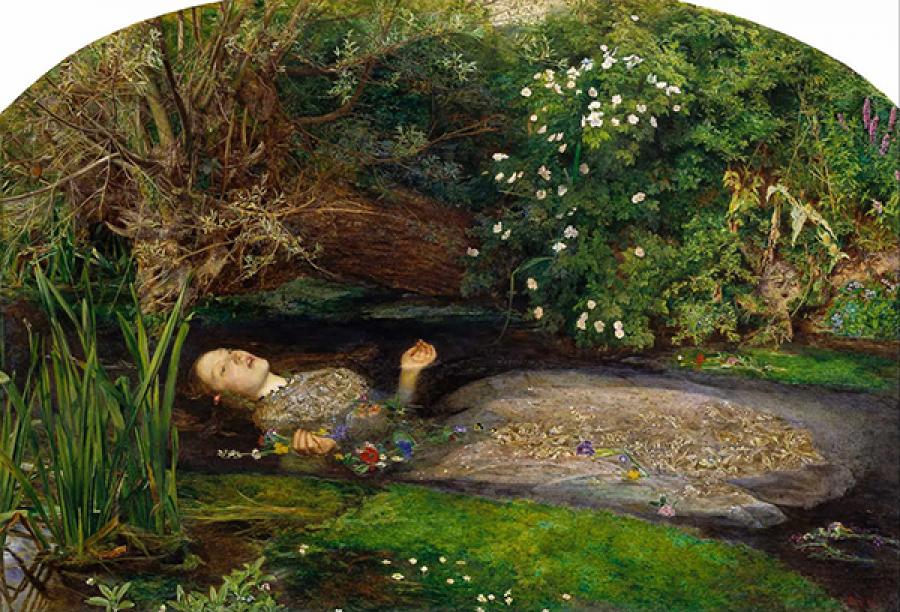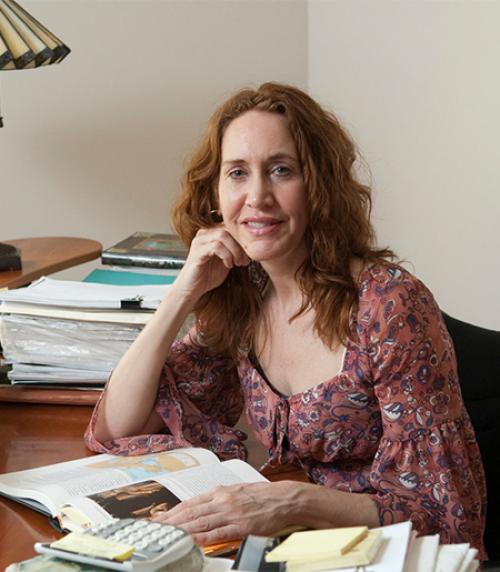"Ophelia"
Housed in the Tate Gallery in London, John Everett Millais’ Ophelia was painted in oil on canvas during the months spanning 1851 and 1852. The image is arresting. Startling blue eyes, pale-pale skin, mouth open as though in speech, Ophelia floats amid lush, incongruous, bucolic beauty. The branches of an old willow shade her; in her hands and along the river banks, art historians have identified blossoms—crow flowers, daisies, daffodils, purple loosestrife—whose bloom-times, impossibly, spread over five months.
Driven mad by her lover’s murder of her father, Ophelia has stumbled while gathering flowers and fallen into the river. She doesn’t drown immediately: the voluminous skirts of her brocaded gown billow around her, buoying her up. Once thoroughly soaked, they will take her down. But in the meantime, she sings. Or so the Shakespeare goes.
I didn’t see the painting until well into my forties, after a walk across London under an umbrella between thunderstorms and fits of sun. When I finally stood in front of it, I was struck by its smallness: 30 x 44 inches. It invited intimate, protracted viewing.
I had viewed it exactly that way, many years before, in a reproduction almost the size of the painting itself.
When I was very small, I had a librarian aunt. On Saturday mornings, she took me with her downtown to the old brick building. High ceilings, intricate moldings and a marble staircase with an ornate wrought-iron handrail, filled with echoes, louder because of the silence of reading people. The place smelled like paper and leather and glue—like books. While my aunt attended patrons, I looked through, and convinced myself I could read, Peter Rabbit, Dr. Seuss, a cleaned-up version of Grimm’s fairy tales. The joke in our family was that if you wanted to keep me quiet, stick a book in my hands, any book, the telephone book would do just fine.
When the library closed at noon, my aunt took me to her house for lunch. Her living room seemed an extension of the library—shelves, floor to ceiling, lining all four walls, filled with books. And on the coffee table, more books, filled with pictures, too heavy for me to pick up. But I could open them, turn the pages. Inside one of those books—maybe a catalogue of the Pre-Raphaelites, or highlights of the Tate’s collection—was Ophelia. My aunt had traveled abroad, the only one in our family to do so, so perhaps she’d even bought it at the museum.
The flowers, the tree, the golden brocaded gown, the river: as I said, the image is arresting, and I was instantly arrested. “That’s Ophelia,” my aunt said, kneeling down beside me, likely annoyed at herself for having left such grown-up fare at such easy access. What was Ophelia doing? My aunt thought for a few seconds. “Well, she was walking in the woods, picking flowers to make a crown for her hair, and she got tired. She’s resting. She’ll get back up in a little bit.”
An answer appropriate to a five-year-old. Not a very satisfying one, though, not even to a five-year-old. “But why is she—”
“Look, aren’t all those flowers pretty?” My aunt went on to name them, and to talk about what some of them meant—daisies for innocence, the pale blue forget-me-nots, both of which were blooming in her front yard, so we went outside to look at them.
It was Tennessee, and if there were daisies it was at least June, which means it was probably hot out, which means that we probably sat on the porch after the walk around the yard, in the shade. And since it was her porch, we probably sat alone. She didn’t get many visitors. My aunt was divorced (not a word I knew when I was five, and not a common occurrence in the south in the mid-1960s; the fact that she was a librarian made her ‘respectable,’ but it didn’t get her invited to a lot of bridge parties).
My aunt lived alone with her son, who was twelve years older than I. She died a few weeks before I began first grade. A bullet to the head, a stray, escaped from my cousin’s gun while he was cleaning it. Or so the police report went.
I don’t know what happened to all those books; I was too young to ask for what I wanted--which was, of course, the book with Ophelia in it—and to be taken seriously. Something in me understood that Ophelia was dead, or that she was about to be, even if my aunt wouldn’t say so, and somehow the sweet surprise on Ophelia’s face, the mounds of green and flowers surrounding her, the moment of Understanding Everything just as everything ceases, transposed themselves onto my memory of the time surrounding my aunt’s death. It makes no sense, of course, because my aunt, though her complexion was fair like Ophelia’s, had black hair, which my grandmother said was out of a bottle. I was judged too young for funerals, but my mother assured me there were flowers upon flowers, and I imagined the ones freed from Ophelia’s slackened hand, floating gaily over the sparkling water.
Years later, at university in a freshman English class, we were given an assignment: write in reaction to a painting. It could be a story or an essay, up to us, as long as a painting was at the center. I had yet to cross the threshold of an Art History classroom, but I knew immediately what painting I wanted to write about. The product of my efforts was a (likely pretty unoriginal) short story from the point of view of Elizabeth Siddall, the model for Millais’ Ophelia. An employee of a chic London milliner when ‘discovered’ by the Pre-Raphaelites, she would later pose for long hours in a heavy gown in a bathtub filled with water, so Millais could get just the effect he was after.
On the day our pieces were handed back, the professor asked me to remain after class. I nervously sipped the cup of faculty-lounge coffee he’d handed me, certain I was headed for an F or at the very least a remonstrance about the poor quality of my work. Instead I was told, with some urgency, that I absolutely had to be a writer.
And so I am—all humanists are writers. I have also recently begun writing fiction again, and getting published. I’m sure my aunt would be proud, in ways my parents could never have been, because they didn’t love books the way she did. The way I do, likely because of her.
A framed print of Millais’ Ophelia, with all its Bad Nineteenth-Century Baggage, hangs in the entryway of my house. Ophelia knows something that we all will, one day. Sometimes I stop and look, repeating the names of the flowers to myself—crow flowers, daisies, daffodils, purple loosestrife—and what my aunt told me each one meant. Some of these grow in my own patio garden, tiny but profusely populated, which has become something of an obsession since moving to Ithaca (everyone knew my aunt had a green thumb, but I was a rather unlikely suspect).
As a child, Ophelia’s flowers bade me look the other way from the unsettling image of death. Today they help me to remember, to think, and to write.
About the Transformative Humanities Project
Faculty in the College of Arts & Sciences share a belief in, and speak often with our students, their parents, and the broader public about, the importance of the humanities for shaping deep and meaningful human lives. These short reflections by our faculty illustrate — in concrete and personal ways — how encounters with the stuff of the humanities have in fact been transformative in their own lives. In composing these reflections faculty were responding to the following assignment: Pick a single work in the humanities that has profoundly affected you — that inspires you, haunts you, changed the way you think about things, convinced you to pursue your life’s work, redirected your life’s work . . . in short, a work that has made your life in some way deeper or more meaningful.
This reflection is one of the many thought-provoking and inspiring faculty contributions to the “Transformative Humanities” project, part of the College of Arts & Sciences’ New Century for the Humanities celebrations. Read more of them on our New Century for the Humanities page.





